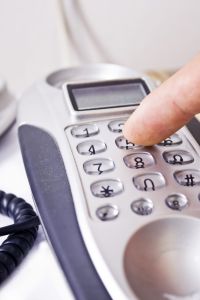Phone-a-thons: Extinct or Re-Purposed?
Updates from October 31, 2011:
We are sharing with you an email excerpt between the author Laura Worcester and ProspectResearch.com reader Marrilee Chamberlain, Manager of the Annual Fund & Alumni Relations at Kuyper College.
Hi Marrilee,
Thank you for copying me on your email—I think, as fundraisers, we can all benefit from this type of experiential insight.
I think it is interesting that your callers had this experience this year. I have certainly heard that, over the years, it has gotten more and more difficult to reach individuals via phone, as more individuals now only have a cell phone. And I agree that individuals often wonder, “what the catch is”, though typically are pleasantly surprised when reassured that there isn’t one—it is just a thank-you call.
I think, in general, part of the success of a Thank-a-thon, especially when trying to ensure that callers stay enthused and motivated—is to set realistic expectations. You might want to share with them that there will certainly be individuals who probably “can’t be bothered” and will just say, “OK, fine” and hang up. Sad, but basic manners these days are pretty much going by the wayside as more and more people become desensitized to auto-calls and telemarketers.
However, try to set an expectation of “half-full” rather than half-empty—just as Major and Planned Gift officers need to expect that probably 7 out of 10 contacts (or so, I am just making a point here, not trying to quote stats!) people they contact won’t want to talk, and maybe only 1 of those 10 will agree to meet, the callers may need to expect similar outcomes (hopefully a little better than this!). And, I have found that donors who are a bit older—perhaps nearing retirement age and beyond—may be a little more receptive to calls, so you may want to do some “testing” to see if demographics make a difference.
I think your idea of sending an “announcement” is intriguing, though part of me feels that this would somehow “spoil the fun” a bit. Part of the effectiveness of a thank you call is the sheer spontaneity of it. I would hate to think that we have to “prepare” donors for good news, but again, it might be a concept to test. There might be value is sending this announcement to a different demographic than I described above: those individuals who tend to be very busy and eager to ignore a call if they thought they were being asked for money again. Perhaps an announcement would quell that concern.
Thanks, Marrilee, for including me on your discussion.
Laura Worcester, Senior Consultant, Target Analytics
From: Marrilee Chamberlain
Hello all – this was a nice article however I have a few observations. We hold an annual Thank-a-thon in the fall (this past month) where our student callers call every donor who has made a gift in the past year. Thanking them for their support, asking how they first connected with us, was there anything they had questions about (the college) and so on.
In past years this has always been a fun and great activity with a high connection rate. We’ve obtained great stories and observations from our donors.
This year however, we had an extremely low connection rate, lots of hang-ups, or folks who just didn’t’ want to be called – as well as many who wondered ‘what the catch was’.
Does anyone else hold a thank-a-thon? Do you do any type of announcement or mailing to donors letting them know this will be occurring? It was quite discouraging for our students and definitely a first since I’ve been here.
Any advice? As we get ready for our Dec. phonathon I almost wonder if there is another tactic to take?
Marrilee Chamberlain, Manager of the Annual Fund & Alumni Relations, Kuyper College
———————————————————————————————————————————————————————————
“Good evening, Mrs. Worcester. This is Suzy So-and-So calling from Creighton University. How are you today?”
 Since graduating from Creighton many years ago, I have received more of these calls than I can count. This one, however, was a little different. The caller continued, “I am calling today to thank you for your recent Annual Fund contribution. And, while I have you on the phone, is there any information I can update for you in our files, or any news we can pass on to the Alumni Office for the newsletter?”
Since graduating from Creighton many years ago, I have received more of these calls than I can count. This one, however, was a little different. The caller continued, “I am calling today to thank you for your recent Annual Fund contribution. And, while I have you on the phone, is there any information I can update for you in our files, or any news we can pass on to the Alumni Office for the newsletter?”
Turns out, they weren’t calling for a gift; they simply wanted to thank me for my past generosity, gather any relevant information and, before hanging up, also asked if they could send me any estate planning information. This wasn’t part of a typical “phone-a-thon” event. Instead, this was a call on behalf of a relatively new effort many development offices are trying out—a “thank-a-thon” or, more precisely, a stewardship activity, not a solicitation. In this age of cell phones becoming the new home phone, and email and social networking replacing snail mail, many tried and true development strategies are being replaced. But, before abolishing a call program all together, ask yourself if you might not want to re-invent it with a little different purpose and with more targeted demographics.
While marketing firms will be more than happy to provide with you all the latest data and demographics on call effectiveness, allow me to briefly share with you my observations of what can still work on the phone front. Creighton did a lot of things right with this call. First, since I had made the gift as a result of a phone call, it was a logical assumption that they could reach me on the same number to thank me. While I am not sure if they call to thank donors making online contributions, it does make a great deal of sense to stick to what works: use the same method to thank that the donor used to give.
In addition, whether I want to admit it or not, my age (53), places me squarely in what is probably a good demographic for what they were doing. Again, while I am not professing to be offering “official” statistics on this, anecdotal information leads me to believe that calling 50-somethings is probably more effective than 20-somethings, who are more likely to respond to email or online giving opportunities. And, asking if I had any information or news to update or pass on is a great way to get address, job or other changes without waiting for the donor to send this info to you. Finally, inquiring about any interest I might have in receiving planned giving information, considering my age and past history of making annual gifts, is a much more proactive way of engaging me in this conversation than simply offering a check off box on an envelope.
So, before you decide to do away with your calling programs, consider your goals and demographics. Calling can still be a very effective tool. It may just be playing a different role (stewardship) in the donor cycle. And, be sure to carefully target the right demographic for the calls. There’s a lot of good will that can be achieved by having an energetic representative from your organization reaching out and just saying, “Thanks”. Give it a try—you might be surprised at what you might gain.
Do you have a great calling program in place at your organization? If so, post a comment to this blog or email me at laura.worcester@blackbaud.com. As usual, I would love to hear from you!
